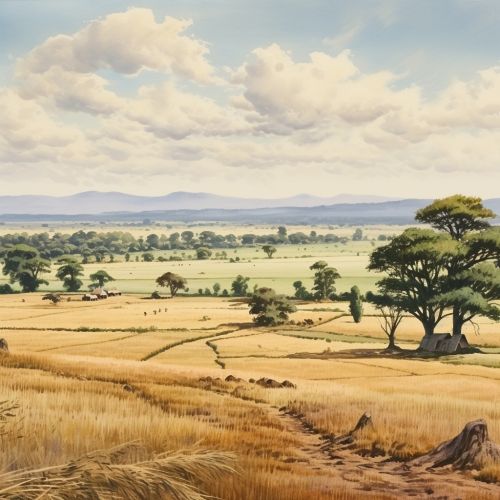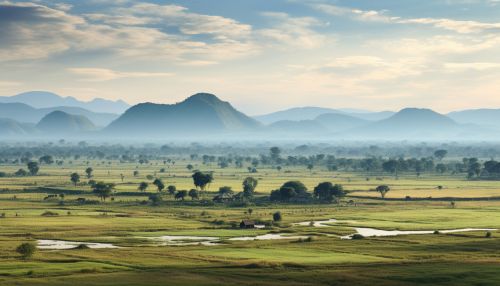Cambodia
Geography
Cambodia, officially known as the Kingdom of Cambodia, is a country located in the southern portion of the Indochina Peninsula in Southeast Asia. It is bordered by Thailand to the northwest, Laos to the northeast, Vietnam to the east, and the Gulf of Thailand to the southwest. The country's landscape is characterized by a low-lying central plain that is surrounded by uplands and low mountains and includes the Tonle Sap (Great Lake) and the upper reaches of the Mekong River delta.


History
Cambodia's history is marked by a period of instability and war, but also by a rich cultural heritage that had significant influence on Southeast Asian culture. The country's history can be divided into several periods, starting with the prehistoric times and the establishment of the Funan Kingdom in the 1st century, followed by the Angkor Empire that existed from the 9th to the 15th centuries, the French colonial period from the 19th to the mid-20th century, the Khmer Rouge regime and the subsequent civil war, and finally the current period of political stability and economic recovery.
Prehistoric Times and Funan Kingdom
The earliest known settlement in Cambodia was a prehistoric site known as Samrong Sen, which dates back to 1500 BC. The first advanced civilizations in Cambodia appeared in the 1st century AD, with the establishment of the state of Funan. Funan is considered to be the oldest Indianized state in the region and had extensive maritime trade with India and China.
Angkor Empire
The Angkor Empire, also known as the Khmer Empire, was one of the most powerful empires in Southeast Asia. The empire was established in the 9th century and lasted until the 15th century. The Angkor Empire is best known for constructing the temple complex Angkor Wat, which is the largest religious monument in the world and a significant symbol of Cambodia.
French Colonial Period
The French colonial period in Cambodia lasted from 1863 to 1953. During this period, Cambodia became a protectorate of France and was incorporated into French Indochina. The French influence can still be seen in the country's architecture, particularly in the capital city of Phnom Penh.
Khmer Rouge Regime and Civil War
The Khmer Rouge regime took power in Cambodia in 1975, after the Cambodian Civil War. The regime, led by Pol Pot, implemented a radical program that included isolating the country from all foreign influences, closing schools, hospitals and factories, abolishing banking, finance and currency, outlawing all religions and confiscating all private property. The regime is known for the Cambodian genocide, where an estimated 1.7 million people lost their lives.
Contemporary Cambodia
Since the fall of the Khmer Rouge in 1979, Cambodia has been slowly recovering and rebuilding its economy. The country has made significant progress in reducing poverty and improving health outcomes. However, Cambodia still faces significant challenges, including political corruption, limited human rights, and high rates of deforestation.
Culture
Cambodia's culture has been heavily influenced by Indian culture, particularly in the fields of literature, art, music, dance and religion. The country's rich cultural heritage is best represented by the Angkor Wat temple complex, which is a UNESCO World Heritage Site. Cambodian culture is also characterized by a strong tradition of dance, both classical and folk. The most well-known dance form is the Apsara Dance, which is based on the classical dance style of the royal court.
Economy
Cambodia's economy is largely agrarian, with agriculture employing about half of the workforce. The main agricultural products are rice, rubber, corn, vegetables, cashews, and tapioca. In recent years, the country has seen a significant growth in the sectors of textiles, construction and tourism. Despite the progress, Cambodia remains one of the poorest countries in Asia, with a large part of the population living below the poverty line.
